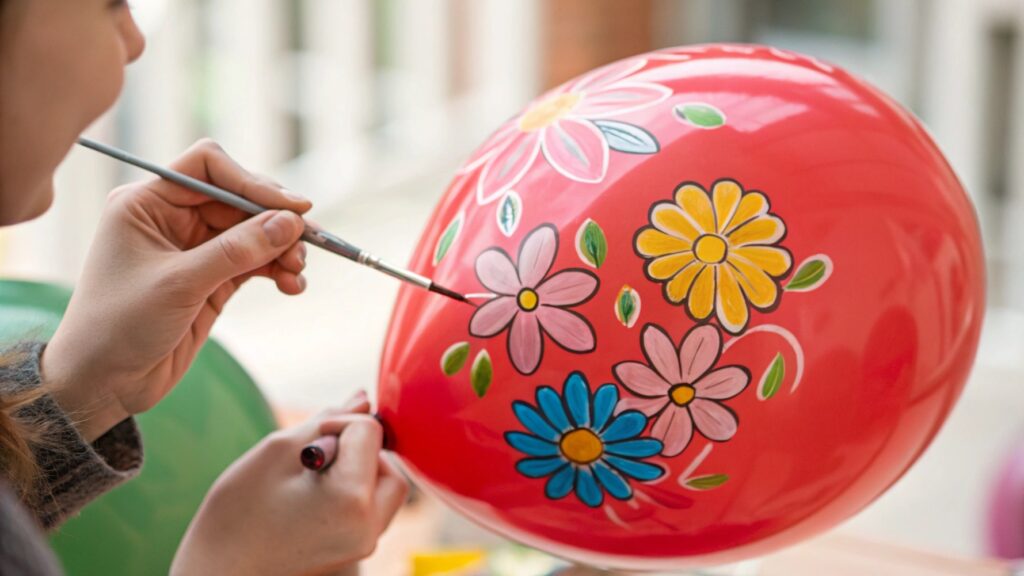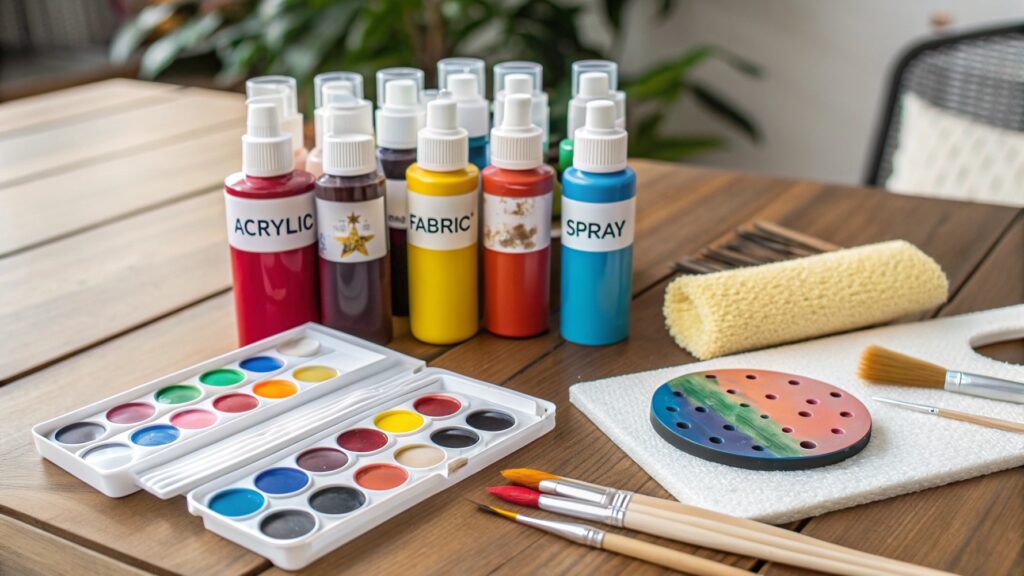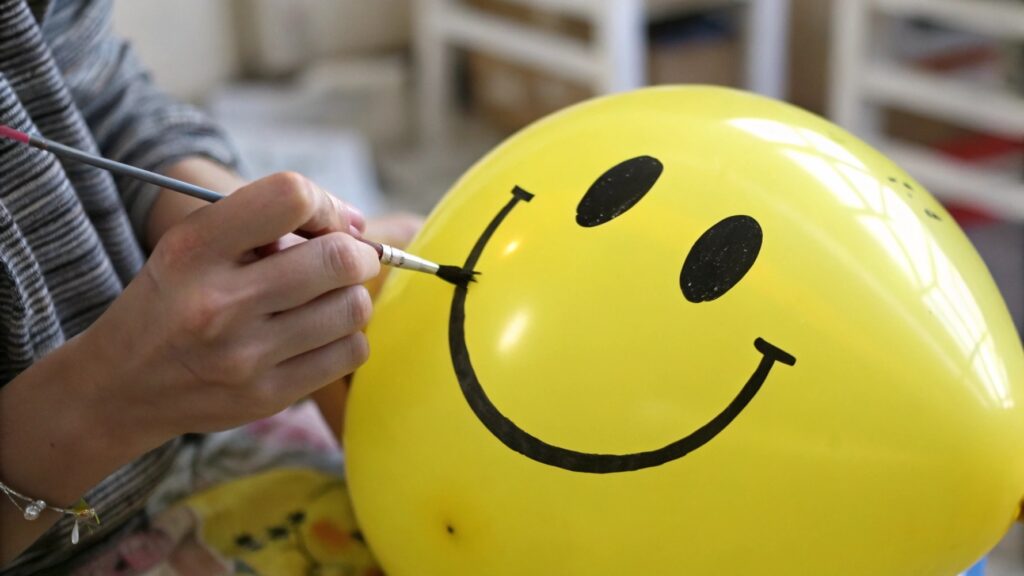Can You Paint on Latex Balloons?
Do you want to add a personal touch to your latex balloons? Many people wonder if they can use paint on them. The good news is, you can!
Yes, you can paint on latex balloons. I have found that acrylic, fabric, and even some spray paint1s work well. Remember to use a light touch and let each paint layer dry completely to get the best results.

Painting on latex balloons can transform a simple decoration into a personalized piece of art. It lets you create custom themes2 for parties, events, or marketing displays. In my experience, choosing the correct paint and using proper techniques are important for success. Let's look at more details.
What Kind of Paint Works Best on Latex Balloons?
Are you looking for the ideal paint to use on your latex balloons? Choosing the right paint is key to a lasting design. I have tested many types over the years.
Acrylic paints are often a top choice. They are water-based and dry quickly. This makes them easy to work with on balloons. Fabric paints also work well. They are flexible and do not crack when the balloon moves or deflates a little. Sticking to these types of paints helps avoid common problems.

When I first started, I tried many paints. Some paints did not stick well. Some made the balloon sticky. But with acrylic and fabric paints3, I found they gave the best results.
Choosing the Right Paint for Your Project
Selecting the best paint for latex balloons4 depends on your specific needs. Here is a breakdown of common choices:
| Paint Type | Benefits | Considerations | Best Use Case |
|---|---|---|---|
| Acrylic Paint | Dries fast, good color options5, water-based | Can crack if applied too thick, needs thin layers6 | Detailed designs, custom messages |
| Fabric Paint | Flexible, resists cracking, stays vibrant | Thicker, takes longer to dry | Large areas, designs that need to withstand movement |
| Spray Paint | Quick coverage, smooth finish | Needs good ventilation, might pop balloon if too close | Base coats, quick color changes |
Acrylic paint is my go-to for detailed work. It gives clear lines and vibrant colors. I always thin it a little with water to make sure it spreads smoothly and dries faster. This helps prevent the paint from cracking when the balloon is inflated or deflated over time. Fabric paint is great for designs that need to last a long time, like event decorations. This is because fabric paint moves with the balloon. Spray paint is good for a solid color base before I add details with brushes. But you need to stand far enough away when spraying so you do not damage the balloon. I have learned through trial and error that testing a small area first is always a good idea. This ensures the paint sticks and looks good.
Will Acrylic Paint Adhere to Latex Balloons?
Do you wonder if acrylic paint will stick to latex balloons? This is a common question I get. Many people worry about the paint peeling or cracking.
My experience shows that acrylic paint adheres very well to latex balloons. It creates a strong bond. The trick is to apply thin layers. This stops the paint from cracking when the balloon moves. I have found that if you apply it too thick, it can become stiff and flake off.

At first, I was worried too. I thought the stretchy surface of the balloon would make the paint just chip off. But after many tries, I saw that acrylic paint truly works if you use it correctly.
Tips for Using Acrylic Paint on Latex Balloons
Acrylic paint is a favorite for many artists, including me, when working with balloons. It offers vibrant colors and good coverage. Here are my tips for getting the best results:
| Tip | Description |
|---|---|
| Prepare the balloon | Make sure the balloon is clean and free of dust or oils. A quick wipe with a dry cloth works well. |
| Inflate properly | Inflate the balloon to its full size before painting. This prevents cracking later. |
| Use thin layers | Apply paint in thin, even coats. Thicker layers are more likely to crack as the balloon moves or deflates. |
| Let each layer dry | Allow each layer of paint to dry completely before adding another. This prevents smudging and helps the paint bond better. |
| Seal your design (optional) | Use a clear sealant7 meant for crafts to protect your design. This makes it more durable and resistant to scratches. |
I always start with a clean balloon. It helps the paint stick better. Then, I inflate the balloon to the size I need. This prevents the paint from stretching too much after it dries. When I apply the paint, I use small brushes for details and a light touch. For larger areas, I use a sponge. I never rush the drying process. I give each coat plenty of time to set. For important projects, I use a clear spray sealer after the paint dries. This adds a protective layer. It helps the design last longer and look fresh. Using these steps makes acrylic paint a great choice for decorating balloons.
Are There Paints That Won't Pop Latex Balloons?
Are you concerned about popping your latex balloons while painting? It is a valid worry. I have seen it happen when the wrong paint or method is used.
The good news is that many paints are safe for latex balloons. Water-based paints like acrylics and fabric paints are generally safe. They have less harsh chemicals. These chemicals can make the latex weaker and cause it to pop. I always steer clear of strong solvent-based paints.

Early in my career, I experimented with different paints. I learned that some paints contain harsh chemicals that can weaken the latex. This makes the balloon pop more easily. So, I learned to select paints carefully.
Understanding Paint Composition for Balloon Safety
Not all paints are created equal when it comes to balloon safety8. The main risk comes from a paint's chemical composition. Here’s what I consider:
| Paint Component | Impact on Latex Balloons |
|---|---|
| Solvents | Many solvents can dissolve or weaken latex. This makes the balloon more likely to burst. Avoid paints that contain strong solvents like mineral spirits or acetone. |
| pH Level | Extremely acidic or alkaline paints can degrade latex over time. Neutral pH paints are generally safer. Most acrylic and fabric paints3 are close to neutral. |
| Drying Agents | Some paints dry by evaporating solvents, which can cool the balloon rapidly and cause shrinkage or stress. Water-based paints evaporate water, which is gentler on the latex. |
| Pigments | Pigments usually do not affect the latex. The binder and solvent are the main concerns. |
From my experience, I always check the label for ingredients. Paints that are labeled “water-based” are usually safe. They do not contain harsh solvents that can damage the latex. I also make sure the paint is not too thick. Thick paint can make the balloon heavy and stiff. This makes it pop more easily. When I use spray paint1, I hold the can far away. This avoids too much pressure and chemicals hitting the balloon at once. I also make sure the area is well-ventilated so the fumes do not sit on the latex. Being careful about the type of paint and how I apply it has saved many balloons from an early pop.
What Are the Best Practices for Painting on Latex Balloons?
Are you wondering how to get professional-looking results when painting on latex balloons? Following some best practices can make a big difference. I have learned these over years of practice.
First, always inflate the balloon fully before painting. This makes sure your design does not stretch or crack when the balloon is later inflated. Then, use thin layers6 of paint. Let each layer dry completely. This prevents smudging and ensures a lasting design.
[^9] on a balloon](https://aihuaballoon.com/wp-content/uploads/2025/07/description-a-step-by-step-scene-showing-an-artis-1024x577.jpg)
I remember making mistakes when I first started. My designs would crack or look messy. Over time, I developed a routine that consistently gives me great results.
Essential Techniques for Successful Balloon Painting
Painting on balloons requires a different approach than painting on other surfaces. The surface is curved, flexible, and non-porous. Here are my top techniques:
| Practice Category | Key Steps |
|---|---|
| Preparation | Clean the balloon: Use a dry cloth to wipe away any dust or oils. This helps paint adhere better. Inflate fully: Inflate the balloon to its final size to prevent cracking when paint dries and the balloon is later stretched. |
| Application | Use light coats: Apply paint in thin layers. Thick paint can crack or pop the balloon. Allow drying time: Let each layer dry completely before adding another to prevent smudging and for better adhesion. Use dabbing vs. brushing: For small details, use a dabbing motion rather than dragging the brush. This helps apply color evenly on the curved surface. |
| Drying | Air dry: Allow balloons to air dry in a dust-free area. Avoid direct heat, which can damage the latex or cause the paint to crack. |
| Finishing | Seal (optional): A clear craft sealant7 spray can protect your design and add durability. Apply it once all paint layers are fully dry. |
I always start with a clean balloon. Any dust or finger oils can make the paint peel off. After inflating, I get my brushes ready. I prefer soft brushes for smooth lines. For broader strokes, a sponge is better. I dip the brush lightly and apply paint in thin layers. I never try to cover a large area with one thick coat. Patience is key. Waiting for each layer to dry saves me from having to restart. For detailed work, I use a stencil. This ensures crisp lines on the curved surface. Finally, if the balloon needs to last for days, I use a clear craft sealant. It protects the artwork even if the balloon rubs against surfaces. Following these steps helps me create beautiful, durable designs every time.
Conclusion
Yes, you can paint on latex balloons! Use acrylic or fabric paints, apply thin layers, and let them dry completely. This will make your custom balloon designs look great and last longer.
-
Find out how to safely apply spray paint for a smooth finish on balloons. ↩ ↩
-
Discover creative ideas for using painted balloons to enhance your event themes. ↩
-
Discover the benefits of using fabric paints for flexible and durable balloon designs. ↩ ↩
-
Explore techniques to enhance your balloon art and ensure lasting designs. ↩
-
Explore the variety of colors you can use to personalize your balloon decorations. ↩
-
Learn how thin layers can prevent cracking and ensure a better finish. ↩ ↩
-
Explore options for sealants that can enhance the durability of your balloon art. ↩ ↩
-
Ensure your painting methods are safe and effective for balloon longevity. ↩
